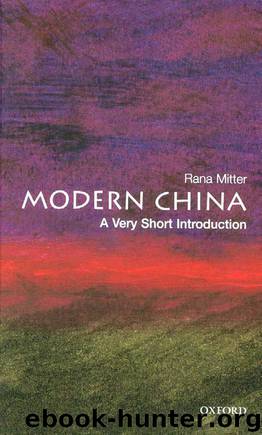Modern China. A Very Short Introduction by Rana Mitter

Author:Rana Mitter
Language: eng
Format: mobi, epub
Published: 0101-01-01T00:00:00+00:00
Chapter 4
Is Chinese society modern?
Zou Taofen, one of the best-known journalists in China in the 1920s, wrote an essay under the title of ‘Equality’ in 1927: Not every person’s natural intelligence or strength is equal. But if each person develops his mind towards service and morality … so as to contribute to the mass of humanity, then he can be regarded as equal. That is real equality.
Modern societies, both dictatorships and democracies, betray the ideal of equality all the time. Yet they are still committed, in their most basic rhetoric, towards a society that breaks down hierarchies and aims, even if imperfectly, towards equality as a goal. Chinese society has changed in a myriad of ways in the past century and more, whether it is the nature of landholding, relations between men and women, or between countryside and city, or in the duties and obligations owed by state and people to one another. This chapter examines some of these areas to ask how far Chinese society has become modern, and whether this is at odds with, or complementary to, maintaining its identity as distinctly Chinese.
74
Men and women
One of the most important areas where that search for equality has been fi ercest is the changing roles of men and women.
Mao Zedong famously said that ‘Women hold up half the sky’, a rebuke to the generations of Chinese men who had regarded women as their inferiors. However, it would be wrong to take the assessment of Mao and other 20th-century revolutionaries at face value, and simply to regard the women of late imperial China as an undifferentiated, oppressed mass, or to assume that the modern era has brought Chinese women today an uncomplicated
‘liberation’.
How far has the role of women changed in Chinese society since the imperial era? ‘Unbound feet’ has been the enduring metaphor Is C
of the change in the status of women in China between the hinese soc
premodern and modern eras. From the 10th century onwards, for reasons that are still unclear, the fashion developed for iet
Chinese women to have their feet tightly bound from an early y modern?
age, distorting the shape of the foot and leaving it shrunken unnaturally small for an entire lifetime. In some ways, this was surprising, as Confucian norms frowned upon the mutilation of the body. Yet the trend spread, and by the 17th century, the writer Li Yu wrote of the women of Lanzhou, in western China: ‘The feet … measure at most three inches, some even smaller … Lying in bed with them, it is hard to stop fondling their golden lotus.
No other pleasures of dallying with courtesans can surpass this experience.’ Not all women bound their feet; it was not the custom among peasant women of the Hakka sub-ethnicity, nor among Manchu women during the Qing dynasty. But for the vast majority of women who aspired to respectable life, it was essential. A mother who did not bind her daughter’s feet was doing her a disservice, for ugly, huge feet would mean little prospect of a good marriage.
Download
Modern China. A Very Short Introduction by Rana Mitter.epub
This site does not store any files on its server. We only index and link to content provided by other sites. Please contact the content providers to delete copyright contents if any and email us, we'll remove relevant links or contents immediately.
| Africa | Americas |
| Arctic & Antarctica | Asia |
| Australia & Oceania | Europe |
| Middle East | Russia |
| United States | World |
| Ancient Civilizations | Military |
| Historical Study & Educational Resources |
The Alienist by Caleb Carr(1545)
The Analects of Confucius by Burton Watson(1145)
On China by Henry Kissinger(1122)
China in Ten Words by Yu Hua(991)
The Last Kings of Shanghai by Jonathan Kaufman(974)
One Bright Moon by Andrew Kwong(866)
Deng Xiaoping and the Transformation of China by Vogel Ezra F(844)
Mao's Last Dancer by Li Cunxin(825)
Three Tigers, One Mountain by Michael Booth(801)
Midnight in Peking by Paul French(800)
Seven Years in Tibet by Heinrich Harrer(794)
The Snakehead: An Epic Tale of the Chinatown Underworld and the American Dream by Patrick Radden Keefe(791)
Big Sister, Little Sister, Red Sister by Jung Chang(743)
Tiger Trap by David Wise(700)
Ancient Chinese Warfare by Ralph D. Sawyer(686)
Modern China. A Very Short Introduction by Rana Mitter(642)
The Open Road by Pico Iyer(633)
Chinese Theology by Chloë Starr(627)
Riding the Iron Rooster by Paul Theroux(618)
